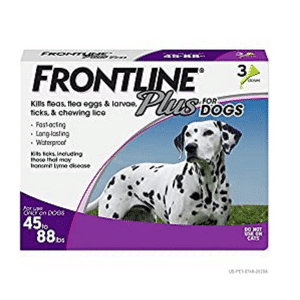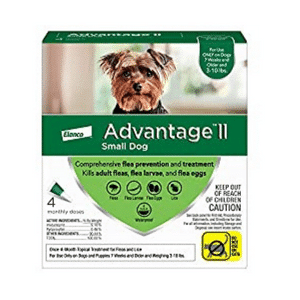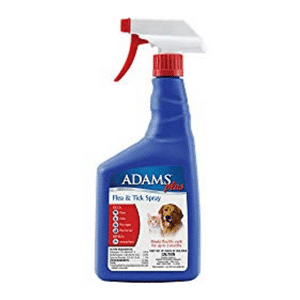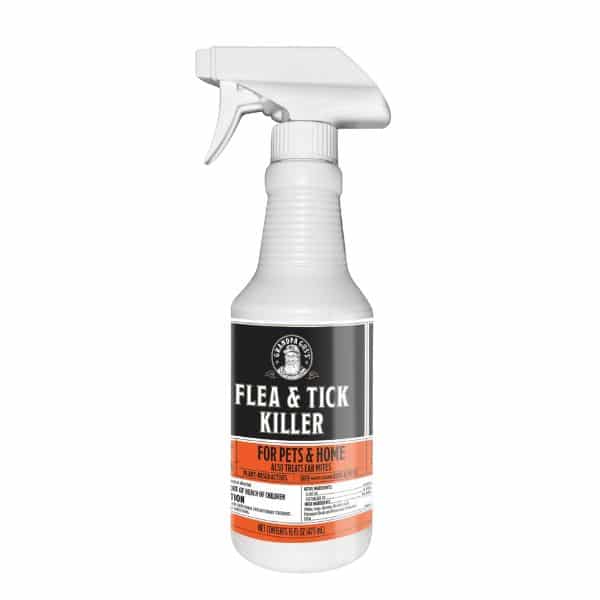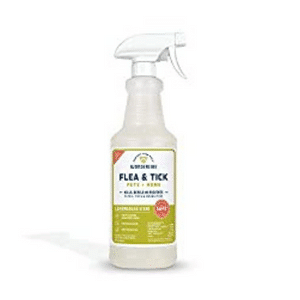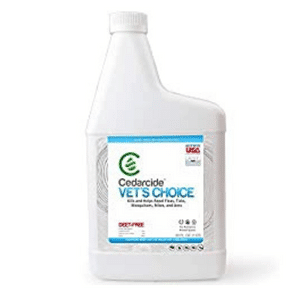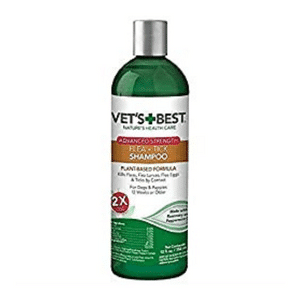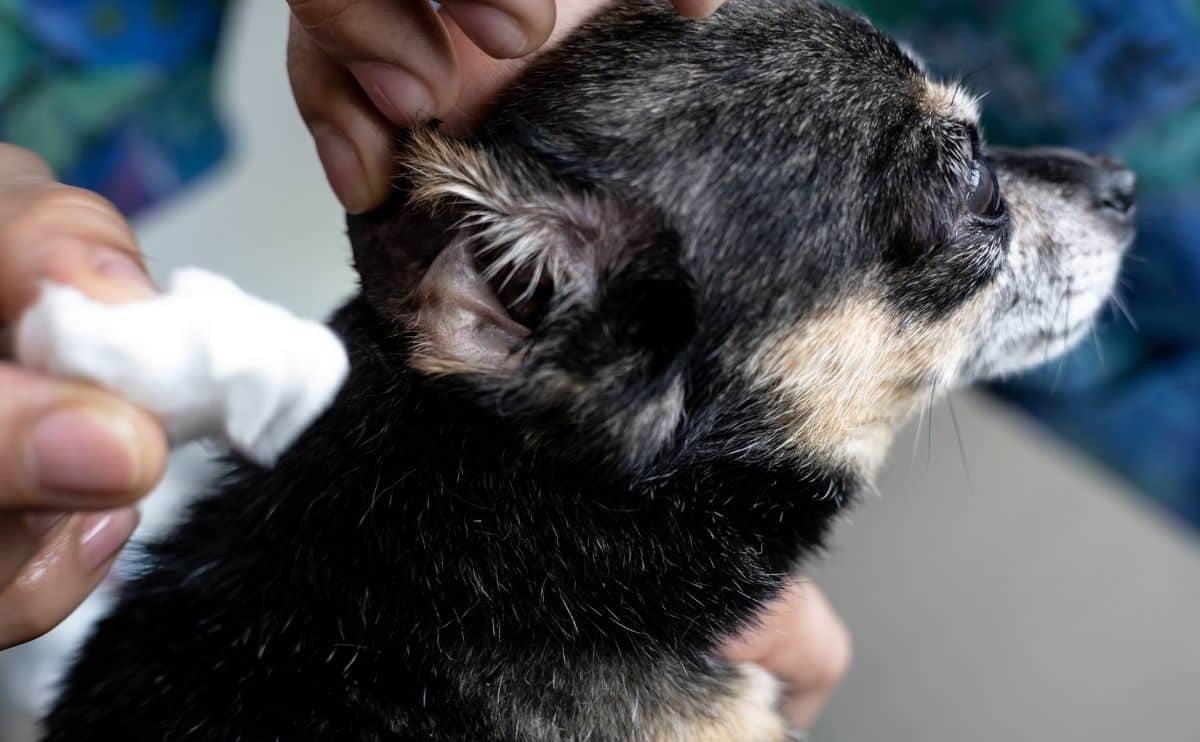Best Flea & Tick Prevention For Dogs: Frontline vs Advantage vs Seresto vs Adams vs Wondercide vs Cedarcide
When you purchase through links on our site, we may earn a commission. Here’s how it works.
| Topical | Shampoo | Natural |
|---|---|---|
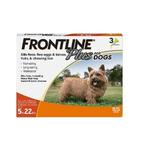 | 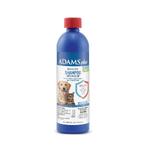 | 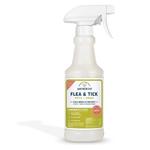 |
| Frontline Plus | Adams Plus | Wondercide |
| View on Amazon | View on Amazon | View on Amazon |
| Read Review | Read Review | Read Review |
Every year, the threat of disease-ridden ticks and fleas becomes more ominous, especially in Virginia, where my family and I live. While my family has a beautiful scenic view of the Blue Ridge mountains from our home, with deer often in our backyard, our lawn backs up to tall grasses and woods that attract ticks and other pests. Tiny loves to roam our surroundings, but he’s brought unwelcome pests into our home. One spring, after finding many ticks in our house (and on me) — and having one of my daughters with suspected Lyme disease — I had had enough. So, I searched for preventative measures to rid Tiny of his (and our family’s) ongoing pest problem. I followed these proactive measures and saw a big difference. Don’t let this happen to you, and stop the infestation before it begins.
Table of Contents
An infestation of fleas can cause a lot of discomfort for your dog, resulting in significant health problems. Additionally, fleas can take over your home and be extremely difficult to eradicate. They can even cause skin issues for you and the rest of your family. Ticks can cause infectious diseases that can enter the bloodstream, including Rocky Mountain Spotted Fever. That’s why flea and tick preventative treatments can reduce the headaches associated with eliminating pesky critters from your home and dog. I’ll share the best options in this flea and tick prevention reviews, including topical oils, collars, sprays, shampoos, dips, and more.
Types Of Tick Prevention & A Vet’s Expert Opinion
Tick prevention comes in two types:
- Repellents (which keep ticks away)
- Acaricides (which kill the ticks).
According to veterinarian Dr. Joanna Woodnutt, MRCVS, “A combination of both is the best way to prevent ticks on pets. Depending on the preventative you use, ticks may still attach and feed, as they must consume the acaricide from your pet’s bloodstream to die. The time from the bite to dying and dropping off varies from product to product, but seeing a tick on your pet doesn’t necessarily mean the product isn’t working. If you can only use one, use an acaricide – repellents don’t work on all ticks, and without an acaricide, your pet is still at risk.”
Woodnutt also says, “There are lots of fake anti-tick collars out there, as well as products that claim to use essential oils and other natural products. It’s best to avoid these. Not only do they have little scientific evidence that they will work, but they also haven’t been through the same testing procedures as drugs have, meaning they may have severe and unexpected side effects.”
What’s The Best Flea And Tick Prevention For Dogs?
There are a ton of safe flea and tick prevention for dogs on the market. Here are some of our recommendations based on their overall reputation and popularity. I always suggest you consult your vet before starting any medical treatment.
Best Topical Treatment: Frontline Plus Review
Topical treatments kill adult fleas and larvae before they hatch, all life stages of four major tick species, and chewing lice. This monthly topical comes in a three-pack or six-pack, with a range of products based on your dog’s weight.
Price
The prices below are for a three-month supply.
- Starts at $39.98 ($13.33 / Count)
Honorable Mention Flea Treatments: Bayer Advantage II Review
Advantage II is another monthly topical flea treatment that kills adult fleas and larvae before they hatch (but not ticks). It’s safe and repels fleas from your dog. It comes in a four-pack or six-pack, and there are products for small, medium, large, and extra-large dogs.
Price
The prices below are for four doses.
- Starts at Check Amazon for availability
Be sure to check out our article comparing Frontline and Advantage II to learn more about these popular, veterinary-recommended products.
Best Shampoo: Adams Plus Review
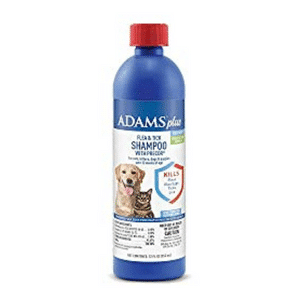
A popular product among pet parents, this shampoo kills fleas, ticks, flea eggs, larvae, and lice and provides 28 days of control for pre-adult fleas. It contains soothing aloe, lanolin, coconut extract, and oatmeal and is safe for dogs, puppies, cats, and kittens.
Price
- 12 oz: $14.99 ($1.25 / Ounce)
Best Spray: Adams Plus Flea & Tick Spray Review
From the makers of our recommended shampoo (above), this easy-to-apply spray gives your dog quick relief from biting fleas. It kills adult fleas, flea eggs, larvae, and ticks and breaks the flea life cycle for up to two months. It’s also helpful in repelling mosquitoes.
Price
- 32 oz: $26.99 ($0.84 / Fluid Ounce)
Best Spray Runner Up: Grandpa Gus Flea & Tick Killer Review
Grandpa Gus’s spray kills fleas, ticks, and ear mites at every stage of their lifecycle. It’s made in the USA and safe for use on furry pets, including pet bedding, crates, and toys, without causing skin irritation. There are no unpleasant smells, it’s non-staining and non-greasy with a light, fresh scent.
Price
Our Personal Experience With Grandpa Gus Flea & Tick Killer
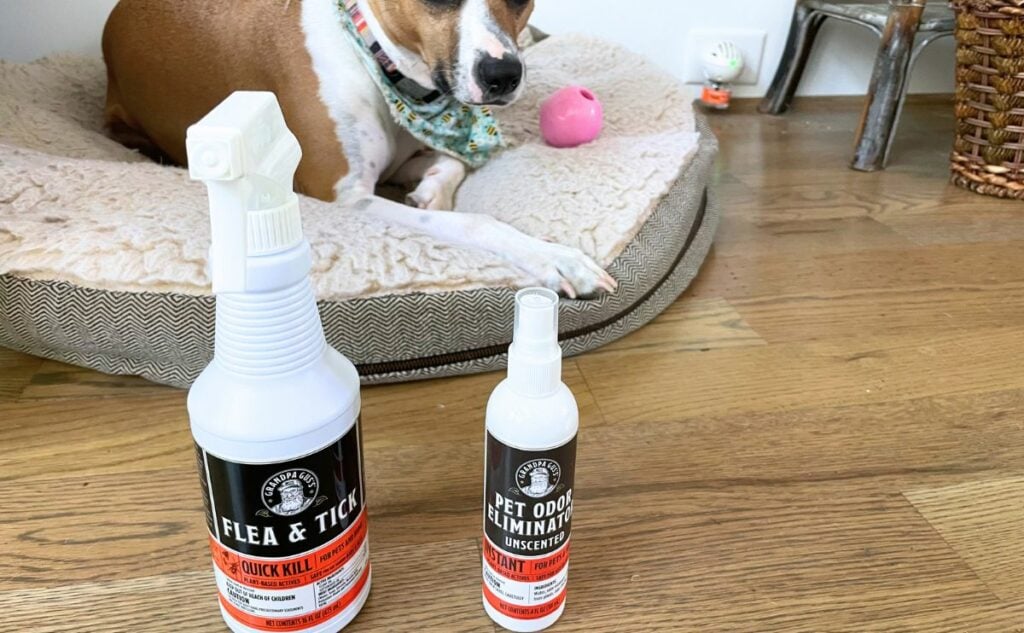
The Flea & Tick Spray is great for extra protection when we go for a walk in the woods. The smell is relatively neutral, so the dogs are not as annoyed as with other sprays when we apply it. Normally, when we put any kind of spray on them, they roll around and try to remove it, but they pretty much ignored this one!
– Michelle Schenker, Co-Founder of Canine Journal and resue dog mom
Products Not Recommended
Collar: Bayer Seresto
This waterproof and odorless flea and tick collar kills fleas within 24 hours of initial application and reinfests fleas within two hours. It also prevents tick infestations within 48 hours after application and kills and repels reinfesting ticks within six hours. This collar lasts for eight consecutive months and comes in various sizes.
However, according to USA Today, this product has been linked to deaths, hair loss, rashes, and neurological side effects over the years, yet the EPA has not issued a warning. So, one of the products above may be a better choice.
Chew Or Topical: Bravecto
Bravecto is not a good choice due to ongoing concerns from our readers and a class-action lawsuit filed against the manufacturer, Merck.
Natural Flea And Tick Prevention For Dogs
Don’t want to cover your dog with potentially toxic chemicals? There are many more natural flea and tick prevention products on the market.
Some experts say essential oils work just as well. Cedarwood, lavender, lemongrass, and citronella are safe choices, but be sure to dilute them in olive oil or sweet almond oil before applying them to your dog.
Soak your dog’s collar in a bowl of water with one drop each of lemongrass and lavender once a week. Don’t overdo it, though, as a dog’s sense of smell is much more sensitive than yours.
If you’re looking for other natural options to prevent your dog from getting fleas and ticks, here are some of our recommendations. You can also learn more in our detailed article on homemade flea and tick prevention.
Best Natural: Wondercide Spray Review
Wondercide’s products include organic, human-grade ingredients that kill the flea and tick life cycle upon contact and provide ongoing prevention. They offer natural sprays, shampoos, oils, and tonics, as well as yard and home control products.
Price
Below is a sampling of Wondercide’s products.
- Ready to Use Flea, Tick, and Mosquito Yard Spray: $37.99
- Flea, Tick, and Mosquito Spray for Dogs, Cats, and Home: $26.99 ($1.69 / Fl Oz)
- View all options
Cedarcide Spray Review
Cedarcide offers several 100% natural and eco-friendly sprays that kill and repel fleas, ticks, mosquitoes, bed bugs, mites, ants, chiggers, flies, moths, and more. They also carry pet-safe flea and tick-repellent granules for your yard. And their pricing is very reasonable for natural products.
Vet’s Best Shampoo Review
This advanced-strength flea and tick dog shampoo contains 100% certified natural essential oils and plant-based ingredients (no harsh chemicals). It kills fleas, flea larvae, eggs, and ticks on contact. This shampoo cleans and deodorizes your dog’s coat with a pleasing rosemary and peppermint scent. It’s safe for puppies 12 weeks and older.
Price
- 12 oz: $13.48 ($1.12 / Fl Oz)
What’s The Best Flea Prevention For Dogs?

It’s crucial to know how to prevent fleas on dogs. Every female flea can lay up to 600 eggs in her lifetime. It’s frightening to think about the possibilities. Some preventative measures you can take to avoid fleas are the same for ticks (see below), but with different pests come various problems to conquer.
How To Apply Flea & Tick Treatments For Dogs
How you apply depends on the type of treatment and product you use. Read the directions on the package carefully to ensure you are using the treatment correctly and the method works properly.
How Does Flea & Tick Medicine Work
How the treatment works also varies depending on what type of product you use (or a combination of treatments). Typically, there is an active chemical in topical medications called Fipronil that goes after the nervous system of the parasites to paralyze and kill them. Shampoos and sprays go an extra step by adding a barrier of scents that deflect, attracting fleas and ticks to dogs’ bodies.
Safeguard Your Yard From Wildlife
Since fleas spread like wildfire, it’s essential to limit wildlife access to your yard. Opossums, raccoons, skunks, deer, coyotes, and even untreated cats and dogs can easily shed flea eggs into a yard. Consider fencing off your yard, for starters. And your local nursery landscape professional may have some tips — specific plants and other landscaping options can help deter animals from your yard.
Use Flea Control On Your Dog
Consider using one of the best flea and tick treatment for dogs products we’ve reviewed above. These include topical oils, collars, sprays, shampoos, and more. You can also give your pup oral treatments that work to control fleas.
If You Find Fleas, Act Fast
Don’t wait if you find even one flea on your dog or in your house. Where there’s one flea, there are likely more fleas or eggs. Treat your pup with a flea control product that kills live fleas and eggs. And be sure to check out our article on how to get rid of fleas in your home.
Consider Professional Pest Control
If you have a severe problem, you may want to hire professionals to treat your yard and house. But do your homework about what kinds of chemicals they use to ensure they are safe for your family members and pets. Some companies may offer natural extermination remedies instead of toxic chemicals. You can also consider going the DIY route by purchasing pet-friendly pest control products.
What’s The Best Tick Prevention For Dogs?
You can take several proactive measures to protect your dog from tick-infested areas.
Avoid Certain Ecosystems
This may seem like a no-brainer, but it’s important to remember these tips.
- Keep your dog away from natural tick habitats. Ticks thrive in dense, wooded, and vegetative areas.
- Avoid woods, tall grasses, overgrown shrubs, and decaying leaves on the ground when walking your dog.
- If you take your pup hiking, ensure he stays on the trail. And, if he strays off-trail, check him thoroughly for ticks before getting home.
Have A Well-Kept Yard
Maintain a tick-free yard. If you have a large, open lawn, you shouldn’t have tick problems (as long as you keep your lawn trimmed regularly). Ticks don’t typically live out in the open. But if your yard borders a wooded area or you have lush gardens and shrubs and shady areas with decaying leaves, your dog is at risk if he roams your yard.
Rake up decaying leaves and keep your garden area and shrubs well-groomed. Another great tip is to make sure your outdoor trash cans have tight lids to keep away rodents and their accompanying ticks from your yard.
Check Your Dog For Ticks Daily
Be sure to check your dog’s head, neck, belly, tail, toes, and in and around ears. Separate the fur with your fingers and check under their collar to ensure ticks aren’t attached to the skin.
Consider Professional Yard Pest Control
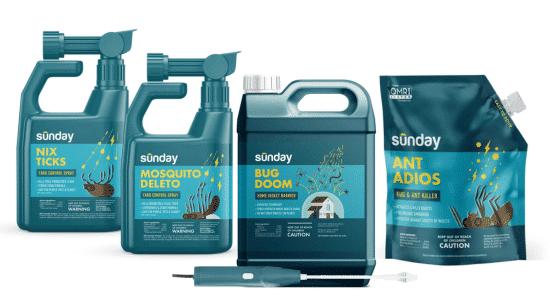
Many pest control companies can treat your yard for both ticks and fleas. But first, do your homework about the types of chemicals they use. Some companies offer more natural treatment options that use essential oils or other natural ingredients. Myself and many others on the team turn to Sunday for offering pet-friendly products. Learn more about their full line of lawn care, including pet control, in our in-depth review of Sunday.
Our Personal Experience With Sunday Nix Ticks
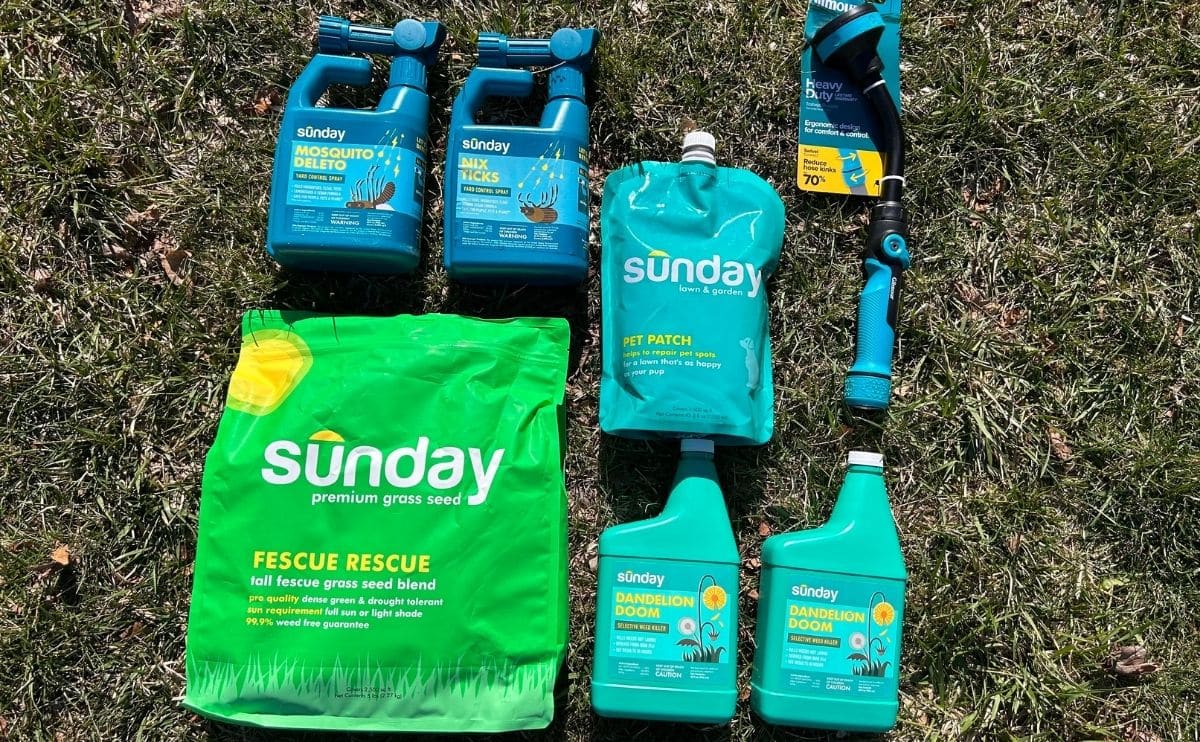
“Sunday sent me Nix Ticks in exchange for an unbiased review. My yard used to be entirely open, so ticks were never really an issue. As I’ve added more shrubs and plants, I’ve seen more ticks around. Nix Ticks has been an easy way to keep the ticks away. The bottle attaches to the hose, and then you spray it directly onto your lawn, shrubs, and trees. I avoided spraying areas with flowers (as the label states). So far, it’s worked great, and my dog hasn’t had a single tick on her this summer. I’ll need to reapply it in 2-4 weeks to keep the little critters away.”
– Kimberly Alt, Parent to Coonhound mix, Canine Journal writer and pet insurance expert
Do Indoor Pets Need Flea & Tick Prevention?
“Ticks and fleas have been found on indoor-only pets, and it’s thought they’ve been carried in on clothing. However, depending on your location, it’s not necessary for every animal to have flea & tick protection all year. It’s all about assessing an individual animal’s risk,” says Woodnutt.
How To Remove Ticks From Dogs (Video)
If your dog gets a tick, watch the following video or read our article on how to check for and safely remove ticks from your dog.
Flea & Tick Prevention Infographic
Check out this infographic our graphic designer created that summarizes how to prevent fleas and ticks, remove ticks, and provide the recipe for our recommended DIY natural flea and tick treatment.

Want More Info On Flea And Tick Control?
The best tick and flea prevention for dogs is just the first step in the ongoing worry we as pet owners have about keeping these pests at bay. I hope these tips empower you to prevent unwanted creatures from infesting your home. But if you need more information about how to kill fleas once you’ve reached that point, be sure to read our article on getting rid of fleas on your pets and in your home and how to treat ear mites on dogs. You can also read our guide to flea and tick subscription options or our review Frontline vs Advantage to get a better handle on which of these popular flea prevention products may be a better fit for your family.
Why Trust Canine Journal?
Sally has over 20 years of experience in human health sciences communications, including 10 years as an expert on pet health conditions and treatment. She’s also spent over a decade researching pet insurance as part of an expert team at Canine Journal. As dedicated canine professionals and long-time dog owners, we test and research the best pet products, not only for our own pups but for all of our readers.
